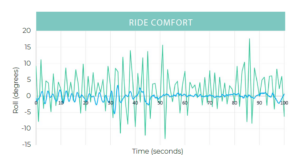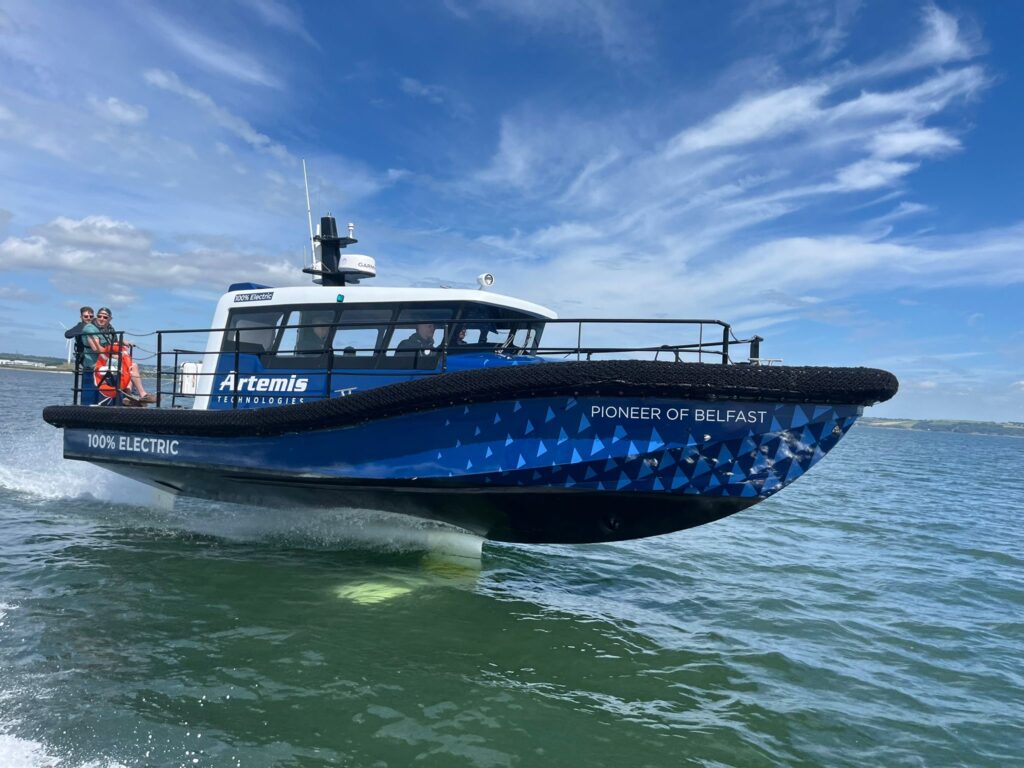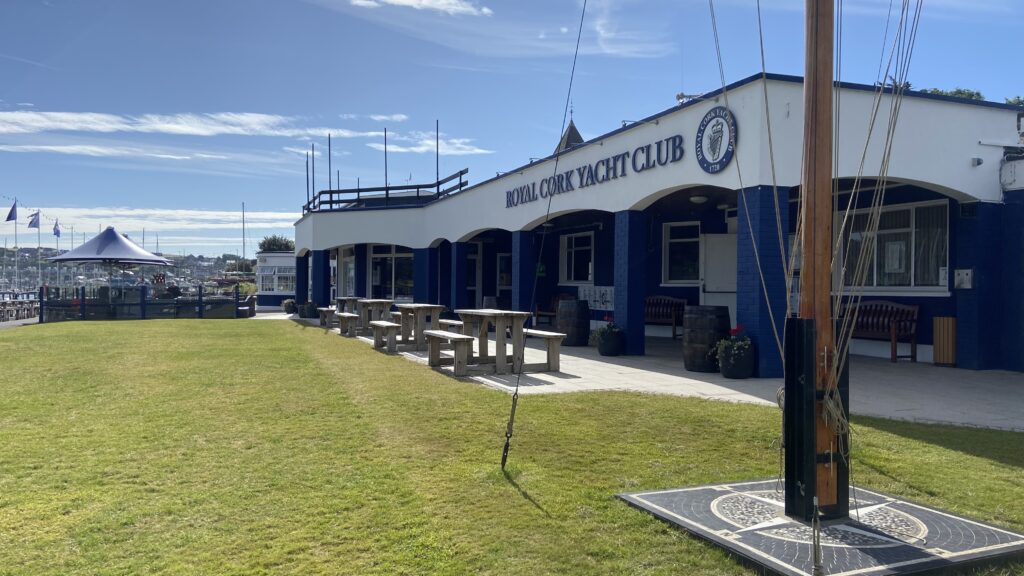As a seasoned mariner who started their career in 1993, I rolled my eyes when I first heard the concept of an electric-powered foiling Pilot Boat. To say I was sceptical would be understating what I thought about this concept.
Despite my initial scepticism, I found myself increasingly intrigued by the potential of this innovative concept. It was a personal transformation, a journey from doubt to belief in the power of pioneering technology.
I first came across Artemis Technologies and decided to delve into their background. Subsequently, I had the privilege of meeting some of their team at a European Maritime Pilots Association General Meeting in Antwerp last May. The passion and enthusiasm that the team exuded for their boats were truly impressive. Their unwavering belief in the potential of the product they represented was evident. I was thrilled when they invited me to witness a demonstration of an Artemis all-electric, foiling workboat in Cork Harbour.
The demonstration was a memorable event that unfolded at the historic Royal Cork Yacht Club, nestled in the picturesque Crosshaven within the beautiful Cork Harbour. Notably, this esteemed yacht club holds the prestigious title of being the oldest yacht club in the world, with its establishment dating back to the year 1720. It was a powerful juxtaposition highlighting the development of pioneering technology within a centuries-old maritime establishment rooted in tradition. I wonder if this was intended or if it just happened to be the most convenient place to launch the demonstration.
The day commenced with an engaging introduction to Artemis Technologies, a company that has grown from the well-known Artemis Racing America’s Cup team. Artemis Technologies is at the forefront of developing electric foiling boats, pushing the boundaries of maritime technology and innovation.
After the impressive presentation on the Artemis EF-12 Workboat, I was intrigued and eager to go out for a demonstration. My initial scepticism quickly transformed into genuine curiosity and a strong desire to experience the vessel firsthand.
We then left the yacht club, and as we walked onto the pontoons and past the yachts, I saw the EF-12 Workboat for the first time. It looked just like a regular boat, nothing out of the ordinary.
When I stepped aboard, I noticed the complete absence of the usual engine noise and a faint whiff of exhaust fumes, creating a relaxed atmosphere. Following a safety briefing, we departed the marina and leisurely passed the rows of moored yachts. The discernible lack of internal vibrations was particularly striking about the boat, and the lack of engine noise was replaced only by a gentle hum emitting from the electric drivetrain. This marked a stark contrast to my typical experience with conventional pilot boats.
As we departed from the marina, the boat skipper carefully and gradually increased the speed. Observing the boat’s transition from displacement to non-displacement mode was fascinating as it began to foil at 14 knots. The experience of cruising Cork Harbour was incredibly comfortable, allowing us to venture as far as Roches Point, located at the mouth of the harbour. The weather conditions on the day were exceptionally favourable, with a gentle breeze and a chop of about 0.50 meters. It was an ideal day for a cruise but not ideal for demonstrating the boat’s sea-keeping abilities in rough weather. Still, Artemis has crossed the North Channel in the EF-12 Workboat between Northern Ireland and Scotland without issues in a 4-metre swell. Which is outside the range of most pilot transfers.
The Artemis EF-12 workboat used for the trial is powered by Artemis’ proprietary high power density battery and electric drive unit, the company offers dual engine variants but the designers state this is purely an option for redundancy rather than a need for more control – unlike traditional pilot boats. The company has worked with Lloyds and DNV to achieve type approval for systems; the hull and foils are built to Lloyds SSC regulation – ensuring these innovative vessels meet commercial regulations. At a cruising speed of 25 knots, the EF-12 workboat has a range of almost 50 nautical miles. With a designated Artemis fast charging system, the boat can be fully charged in approximately one hour.
The boats in question are installed with a flight control system which keeps the boat level and stable both when foiling and in displacement mode e.g. when transferring a pilot. . This advanced system is fully automated and operates by utilising a network of sensors and inertial measurement units strategically positioned throughout the hull to control the foils. Notably, the boats can be easily manoeuvred without requiring specialised training, making them accessible to anyone who currently manoeuvres pilot boats.
To further validate the stability benefits the Artemis Technologies shared the following with me

This chart shows the degrees of roll for the Artemis eFoiler®EF12 vessel in blue, and its outboard powered displacement sistership in green. This is measured on the vessels whilst operating at sea via Inertia Measurement Units (IMUs)
The boats are accelerating from 0-30 knots side by side – you can see significant roll reduction at slow speeds then at 50 seconds when the eFoiler boat moves into foiling mode (“take off”) the active roll-control is maintained at near zero degrees
The absence of internal combustion engines in the vessel’s maintenance significantly reduces costs compared to traditional pilot boats. Moreover, the complete lack of internal combustion engines means you do not have the expense or emissions associated with diesel fuel.
Artemis has recently conducted a comprehensive study comparing the energy requirements of one of their conventional crafts to a foiling craft. The study revealed a significant contrast in energy needs between the two types of vessels.
The table below shows the energy requirements for a diesel craft and an electric foiling craft with the same hull operating in 0.1 mHS and 0.6 mHs seas.
Artemis eFoiler® EF-12 Workboat | Gasoline powered 12 metre displacement sistership | |
Energy consumption at 17 kts and 0.1m HS | 6.53 kWh/NM | 38.0 kWh/NM |
Energy consumption at 17 kts and 0.6m HS | 6.92 kWh/NM | 52.1 kWh/NM |
This substantial difference highlights the potential for significant energy savings the electric foiling craft offers, making it a promising option for more efficient and sustainable marine transportation. Artemis presents an environmentally friendly and economically efficient option for curbing emissions in our harbours, with the added advantage of producing zero emissions.
The maritime industry is experiencing a profound shift in energy usage for powering ships. With increasingly stringent emissions regulations being enforced, exploring and implementing innovative solutions to address these issues has become imperative. Furthermore, within our ports, a significant environmental and social responsibility exists to proactively minimise emissions and noise pollution, aiming to enhance the quality of life for individuals residing near port areas. I work as a Maritime Pilot on the Shannon Estuary, a designated special conservation area under the EU Habitats Directive. As a result, there is a greater expectation to operate environmentally and sustainably. Finding solutions to make this possible is difficult as our industry struggles to keep pace with legislative change and public expectations.
As I drove home from the Royal Cork Yacht Club, about two and a half hours away from my home, my mind was filled with thoughts about the impressive demonstration I had just witnessed. Behind the wheel, I reflected on my initial scepticism towards the all-electric foiling boat. The deep introspection inspired me to draw parallels between my long-standing experience with a hybrid car and my reservations about the all-electric boat. I reconsidered my initial doubts as I reflected on how seamlessly the decade-old hybrid vehicle had operated without any hitches. I realised my scepticism was rooted in my bias towards tradition and reliance on what I had known and trusted in the maritime industry for the past three decades. The boat used for the demonstration has been operating with Artemis for two and a half years. The company states they have commenced the build of the EF-12 Pilot Boat with the first customers receiving a Maritime and Coastguard Agency coded vessel in 2025.
I look forward to seeing one on the water and am sure it will be a positive step-change for pilot safety/comfort and decarbonising port operations.
Patrick Galvin,
Vice President at European Maritime Pilots’ Association (EMPA)




